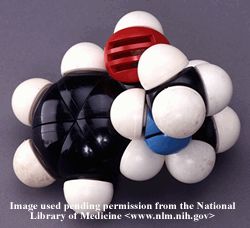
 Ephedrine
is a sympathomimetic drug, that is, it stimulates the sympathetic nervous
system by mimicking epinephrine (Ramsey et al., 1998). It is known
to exhibit agonistic activity on alpha-1, beta-1, and beta-2
adrenoreceptors, resulting in vasoconstriction and increased heart rate
(Caveney et al., 2001).
Ephedrine
is a sympathomimetic drug, that is, it stimulates the sympathetic nervous
system by mimicking epinephrine (Ramsey et al., 1998). It is known
to exhibit agonistic activity on alpha-1, beta-1, and beta-2
adrenoreceptors, resulting in vasoconstriction and increased heart rate
(Caveney et al., 2001).
The proposed cellular mechanism is as follows:
- Ephedrine binds to an adrenoreceptor, causing the activation of a G protein, by exchanging its GDP for GTP.
- The activated G protein then causes adenylyl cyclase to catalyze the formation of cAMP from ATP.
- The increased concentration of cAMP leads to the activation of protein kinase A.
- Protein kinase A phosphorylates two proteins: glycogen synthase and glycogen phosphorylase kinase (Purves, et al., 2001).
- Phosphorylated glycogen synthase is rendered inactive and therefore unable to synthesize glycogen from glucose.
- Glycogen phosphorylase kinase is rendered active and catalyzes formation of glucose from glycogen (Davis, 1998).
Caffeine is nearly always coupled with ephedrine in dietary supplements. In conjunction, the two compounds have been shown to have a somewhat synergistic effect on the sympathetic nervous system. Caffeine causes vasoconstriction by antagonizing adenosine receptors, which would otherwise cause vasodilation in the presence of adenosine. Furthermore, a recent study speculated that caffeine's ability to increase the release of catecholamines (epinephrine, norepinephrine, dopamine, etc.), coupled with ephedrine could also contribute to the stimulatory effects exhibited by dietary supplements that contain the two substances (Haller and Benowitz, 2001).
© Copyright 2001 Department of Biology, Davidson College, Davidson, NC 28036. Send comments, questions, and suggestions to: jokogoy@davidson.edu





